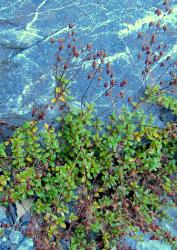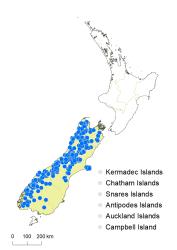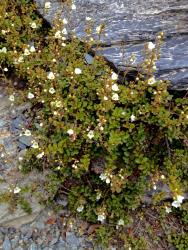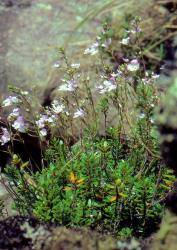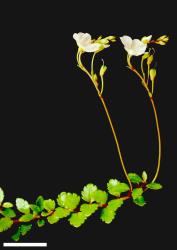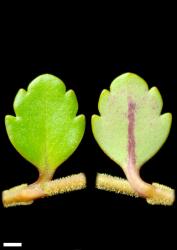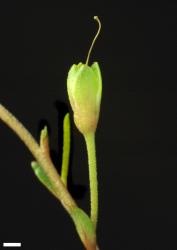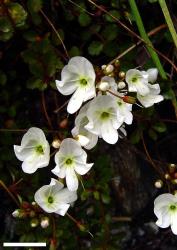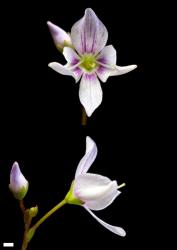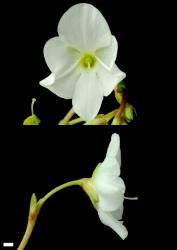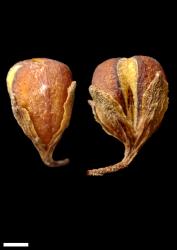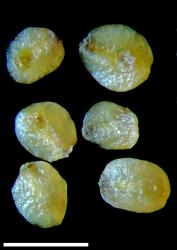- Taxon
- Gallery
- ≡ Hebe lyallii (Hook.f.) A.Wall, Trans. & Proc. New Zealand Inst. 60: 385 (1929)
- ≡ Parahebe lyallii (Hook.f.) W.R.B.Oliv., Rec. Domin. Mus. 1: 230 (1944)
- = Veronica lyallii var. suberecta Cheeseman, Man. New Zealand Fl. 543 (1906)
- = Veronica lyallii var. angustata Petrie, Trans. & Proc. New Zealand Inst. 49: 53 (1917)
Sub-shrub to 0.3 m tall. Stems prostrate to erect, eglandular-pubescent; hairs bifarious or uniform. Leaf bud indistinct; leaves separating while very small, opposite-decussate to sub-distichous, erect to recurved; lamina sub-coriaceous, ovate, elliptic, orbicular, deltoid, or rhomboid, 3–15 mm long, 2–10 mm wide, dull to glossy green to dark green above, dull pale green to pinkish beneath; midrib evident; surfaces glabrous or with eglandular hairs along midrib above; margin glabrous, crenate or rarely serrate, teeth or lobes in 1–4 pairs; apex rounded to obtuse; base cuneate to truncate; petiole 1–3 mm long. Inflorescence a lateral raceme, 50–200 mm long; flowers distant, 5–15, all bisexual; bracts alternate, linear to ovate or elliptic, < pedicels; pedicels erecto-patent, incurved at fruiting, 8–25 mm long, eglandular- or glandular-hairy all around or glabrous. Calyx lobes 4, sub-acute to acuminate, 2.0–4.5 mm long, eglandular- to glandular-ciliate. Corolla 8–15 mm diameter; tube white and yellow,1.5–2.0 mm long, < calyx, eglandular-hairy inside; lobes 4, white, rarely pale purplish or pink, unequal, spreading, elliptical or orbicular, 3.5–7.0 mm long, obtuse, posterior occasionally emarginate; nectar guides magenta, purple, pink, or absent. Stamen filaments white, 2.5–4.0 mm long; anthers white or pink. Style glabrous, 3–5 mm long. Capsules angustiseptate, didymous, glabrous, 3–5 mm long, 3–4 mm at widest point. Seeds discoid to ellipsoid, strongly flattened, smooth, pale to dark brown, 0.6–1.0 mm long.
V. lyallii is generally easy to distinguish among the speedwell hebes, but some plants can be confused with other species. The small, broad, rounded, often dull and bronze-green, crenate leaves are characteristic. Small-leaved and low-growing plants of V. lanceolata from the North Island, especially lowland Wairarapa, and plants of V. hookeriana with glabrous leaves, have sometimes been identified as V. lyallii. V. lanceolata leaves have serrate margins and tend to be sub-acute to acute, whereas V. hookeriana usually has coloured flowers, glandular inflorescences, and often hairy leaves. V. lyallii is absent from the North Island.
In the South Island V. lyallii is most likely to be confused with V. decora. V. decora plants differ in having strictly prostrate, usually blackish main stems, much smaller, glossy-green leaves with just one or two pairs of lobes at the base, tall stout peduncles, and the lowermost flowers usually forming a whorl of three. The two sometimes hybridise.
Lowland to sub-alpine (rarely alpine) stream and river bank rock crevices and gravel, screes, slips, cliffs, seeps, stony sites. Recorded elevations range from 91 to 1554 m.
Where V. lyallii grows with V. decora, hybrids (V. ×bidwillii Hook.) may occur. These are morphologically intermediate and sterile.
In Nelson, some large-leaved plants with toothed margins might reflect hybridisation with V. lanceolata.
In Fiordland, putative hybrids with V. catarractae are common. These have larger leaves with more prominent toothing. A range of plants intermediate between the two parent species are also found, suggesting backcrossing occurs.
Flowers: December–March, extending occasionally until June; fruits: January–June, persisting all year.
2n = 42 (Frankel & Hair 1937; Hair 1970 as Parahebe lyallii).
Veronica lyallii is classified in V. subg. Pseudoveronica sect. Hebe (Albach & Meudt 2010). V. lyallii belongs with V. decora and several other species in a clade (speedwell hebes, Albach & Meudt 2010) that is characterised by short corolla tubes, nectar guides on the corolla, and rather lax inflorescences. Most also have plicate lateral corolla lobes, which enfold the stamens, as does V. lyallii.
Some populations of V. lyallii in north-west Nelson are hard to place, especially plants with larger, sub-coriaceous, ovate leaves and coarse teeth from montane localities such as at Cobb Valley. Some of the larger, narrow-leaved forms (V. lyallii var. angustata), such as at Upper Tākaka, are particularly confusing. The similarities between plants at Kaituna River, near Bainham, and V. lyallii var. angustata are discussed below and under V. lanceolata.
V. lyallii is variable across its range, especially in Nelson. Some of the variation is attributable to plastic responses to the environment. Variability of indumentum, leaf shape, and leaf tooth shape seem to have a genetic basis, but the patterns are largely clinal.
In plants from Westland, Nelson, and in Canterbury northward from the Waimakariri River, stem pubescence is mostly bifarious (uniform further south). At low altitudes north of the Buller and Hurunui Rivers, leaves are usually slender, with length 1.5–2.0 × width. The narrowest leaves are in Buller and north-west Nelson (V. lyallii var. angustata). Many plants from Nelson have dense, transparent, glandular hairs on inflorescences. Some plants from Nelson and Buller have pale blue or purplish corollas, compared with mostly white corollas further south.
Nectar guides may be present or absent, and are magenta when the corolla is white, but tend towards mauve when corollas are blue. Plants on Banks Peninsula have bright green glossy leaves.



